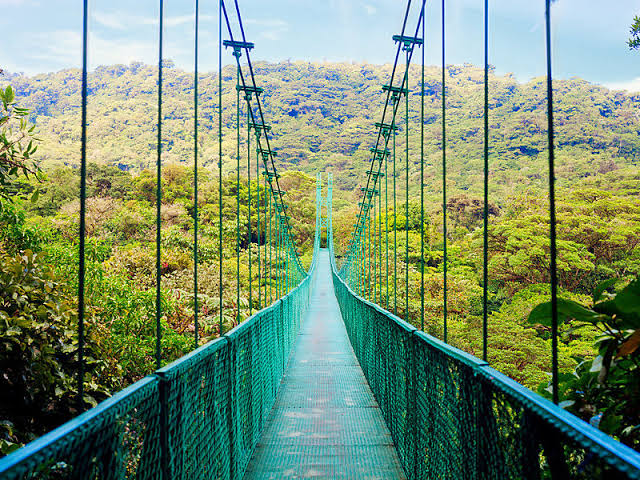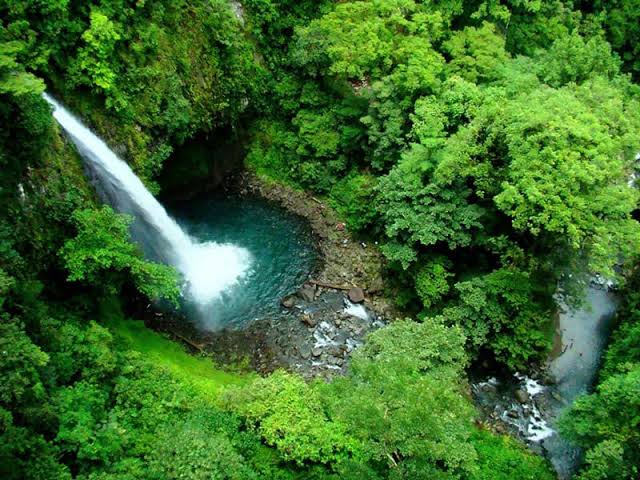
Costa Rica is considered one of the best destinations for ecotourism in Central America, with excellent infrastructure and great biodiversity. The country occupies a narrow area of Central America and is bathed by the Pacific and Atlantic oceans.
Costa Rica borders Panama and Nicaragua, has a territory of only 51,100 square kilometers, but has large preserved areas and offers visitors national parks, volcanoes and beaches paradise.
Don’t be surprised if you don’t find addresses, in Costa Rica they don’t put street names or house numbers. You begin to orientate yourself by the distance, by the constructions and even the colors. But don’t worry, Costa Ricans love tourists and love to help them in a friendly way.
Costa Rica the pearl of Central America
The island of Costa Rica has a privileged location, as it extends from the Pacific Ocean to the Caribbean Sea along 51mil kilometers where beaches await tourists with crystal clear waters and clear sands, national park with a magnificent mountain climate remembering here the landmark Jurasik Park film, and finally ideal paradises for the practice of various water sports, including surfing, wind surfing and finally sport fishing so famous within the island.
In Costa Rica towards the pacific coast the best beaches are: Esterillos, Jacó, Hermosa, Boca Barranca and near the Ballena Marine National Park and in the gulf sector, where the well-known “long left wave” is formed.
If on the contrary the traveler’s preference is the mountain climate, rivers, flora and wildlife are also in the right place since the small Costa Rica has 20% of its territory as protected areas corresponding to forest reserves and national park. In Costa Rica the most valuable historical and natural heritage is protected.
Although the beaches are the fortress of this hidden paradise in Central America here ecotourism lovers will feel better than at home, and is that the country hosts the only international park in the world. This is a protected area that was created jointly between the governments of Panama and Costa Rica consisting of about 400,000 hectares that bear the name International Park Friendship.
This reserve is constituted by a great variety of humid and rainy forests as well as it shelters a score of indigenous tribes of both countries. Most of this reservoir is comprised of the region of Talamanca which has the particularity of having a high index of conservation at the natural level and in the customs of its inhabitants which in general makes it difficult to access for tourism appreciation.
How to get to Costa Rica:
To get to Costa Rica by air is very easy, the country is located in the center of Central America and is covered by most of the world’s airlines. International flights are generally made through Juan Santamaria International Airport in San Jose. Don’t miss our offers to Costa Rica.
What to do in Costa Rica:
Beautiful river located in the Tenorio Volcano National Park. Its waters are an impressive blue due to the volcano that pours salt into the river. To get there you have to do a walk of about two hours, but it is worth the effort. On the way there is also a waterfall about 10 meters high, with blue waters, very beautiful.
Visit to Arenal Volcano
One of the main attractions of Costa Rica is the Arenal Volcano. It takes a lot of luck to be discovered, but when it happens it is undoubtedly one of the most beautiful shows you can see in the country. The site also has hotels that offer guests pools with hot springs that spring from the volcano.
Manuel Antonio National Park
The Guayabo National Monument, in Turrialba, is the country’s main archaeological site. Above, stone spheres in their original site, Valle del Díquis, Palmar Sur, Osa region, Puntarenas.

The park has several beaches and has good infrastructure of hotels and restaurants, it is a beautiful and preserved place. This natural reserve is very rich in animals, plants and beautiful beaches. It can be seen in a natural environment monkeys, sloths, reptiles and, at the same time, enjoy the warm, clean and calm waters of the park.
Conchal Beach
This beach has coarse sand and many pieces of shell. The water is completely crystal clear. There are rock formations that form small pools still in the shallow waters. It is worth wearing a diving mask or renting it, as it is possible to see many colorful fish near the rocks.
Old Woman’s Corner
Rincon de la Vieja National Park is one of Costa Rica’s most ecologically diverse parks in terms of flora and fauna. In the area there are also two volcanoes, Rincón de la Vieja and Santa María, as well as thirty-two rivers and streams.
What is the best time to visit Costa Rica?
There are two major seasons in Costa Rica: the dry season (which occurs from December to April and marks the high season for tourism) and the rainy season (May to November, during which tropical storms tend to fall on the country).
The best tourist places in Costa Rica
Manuel Antonio
This is one of the most recognized national parks in Costa Rica. Manuel Antonio Park is located in the province of Puntarenas and is one of the most beautiful there is.
Full of paradisiacal beaches, fauna and vegetation, it will make you never want to leave it. However, don’t be careless. Monkeys, raccoons, some animals in the area, are likely to steal your food.
Old Port
The town of Puerto Viejo is located on the Atlantic Coast, specifically in the province of Limón. It has one of the most beautiful landscapes you can find in Costa Rica. Anywhere in the place, tourists will get crystal clear waters and turquoise blue, and even waves for surfers.
Simple restaurants that will allow you to relax and enjoy excellent Caribbean food. We recommend that you try a beer, the Patí, and also taste the “rice and beans” that the locals love.
The South Coast
Although it could be said that it is one more road, the route that goes through it is spectacular. This route passes through some of the most beautiful beaches that Costa Rica has. Those who travel through it for tourism, begin their journey through San Jose, meeting the sand of Jacó. Although this one is very popular, it is not by far the most beautiful in the country.
After this, you will find the beaches of Quepos and Manuel Antonio. If you follow your tourist path along La Costanera you will find beaches that are difficult to access and do not have a name. These beaches have natural landscapes that few people will be able to visit elsewhere. Before arriving at Punta Uvita and joining the inter-American highway you will cross the Marino Ballena National Park.
